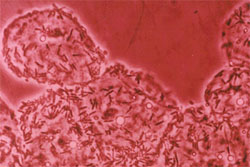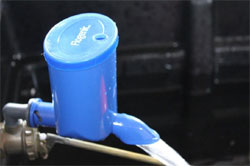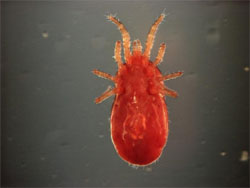



Biosecurity for the Modern Poultry Farmer
UK - Biosecurity is a term that has been discussed for many years but the goalposts keep moving. From initial concerns that the problem was caused only by the feed Optivite now realises that feed is not the source of the problem with just 1.3 per cent of poultry meals and 1.1 per cent of poultry extrusions testing positive in the UK in 2010.At the same time there were 474 Salmonella incidents in broilers reported in 2010 – up by 7.2 per cent from 2009 accounting for 73 per cent of the incidents with layers testing positive at 21.7 per cent.
It is clear that feed can be a source of disease but it is not the only one and any biosecurity programme needs to encompass all sectors of poultry production and finally help realise the importance of the intestine of the chicken as part of the immune system.
Optivite have for many years been working with poultry farmers to find cost effective, simple solutions to tackle the problems of biosecurity.
Feed

Broiler feed is generally pelleted and thermal processing should remove Salmonella and other enteropathogens such as Escherichia and Campylobacter, layer feed on the other hand is more often than not supplied as non-heat treated mash. Yet broilers have a higher incidence of Salmonella than layers.
Treating feed with an antimicrobial agent that survives the pelleting process and also works in mash feeds will maintain the biosecurity of the feed and minimise the threat of post-process contamination during bagging, transport, on farm storage and in the feeder lines. Liquid products driven off during conditioning are therefore not ideal and protected acids, with known activity against the major enteropathogens, are required. Such protected products should have controlled volatility to work in the feed but not to be driven off during pelleting. Encapsulation traps the volatiles in a fat layer which either breaks down during pelleting or traps the actives until released by the pancreatic lipases.
Whatever product is used however must be permitted for feeding to poultry and must have proven efficacy. Not all products used in poultry feed are approved for use with poultry and some have serious health effects on workers handling these feeds. Organic acids are naturally occurring and when buffered to a physiologically active pH and adsorbed onto a carrier, they are easy to use. “The need for a safe and effective product to combat pathogens from raw materials, to protect feed during transport and storage and still have residual activity to enhance the intestinal health of the bird has been our goal and our results support our products,” says Sarah Osborne UK Sales Director.
For broilers, with their short lifespan Optivite recommend a potent acid blend that is safe to use as it is a carrier based acid blend that protects feed and releases acid in the crop and proventriculus to boost the gastric barrier. In trials this product has been effective at maintaining birds at full genetic potential.
For layers the requirements are different, feed is not always heat treated, birds live considerably longer and the feed is heavily buffered with calcium salts to maintain egg shell quality and skeletal strength. In this situation acid levels in the intestine will be compromised so it is essential to promote a microenvironment in the intestine to support the natural commensal microflora. To achieve this Optivite use a more heavily buffered acid combination with a larger carrier matrix that will carry physiologically buffered acid into the intestine on a colonisable carrier. The effect of this product is to promote colonisation by the acid tolerant microflora that normally exist but that are declined the opportunity by a hostile pH resulting from high levels of limestone in the ration. The result is the multiplication of Lactobacilli and Bifidobacteria to produce lactic acid which biologically buffers the intestinal pH as nature intended. The carrier matrix also contains high levels of cellulose and water insoluble mannans that can be digested by cellulose digesters to butyrates in the hindgut to maintain epithelial integrity and assist in immunity.
Using probiotics and competitive exclusion products works in much the same way but without the acidified platforms these live bacteria can fail to colonise. Even if they do they are not necessarily the “correct” species with many probiotics relying on soil bacteria not normally found in the gut and competitive exclusion products derived from intestinal contents from birds on different ration formulations.
Water

Another major intake that is often overlooked is water. Birds drink 1.6 to 2.0 times as much water as feed and the volume increases with age. Water quality can be very variable with “town” water being chlorinated down to bore-holes, wells and surface water extraction. Even “town” water can be stored in header tanks to provide the steady pressure required for nipple drinkers, these tanks are often not easily accessible and can become contaminated with dust, insects and even rodents. Contaminated water immediately affects every bird in the flock so the problem is not isolated.
A simple dosing system is required to ensure water quality is never compromised. Optivite offer a high quality tablet that is effervescent and dissolves in minutes to treat drinking water safely. The tablets are strong so that they do not crack of flake so that dosing is always accurate. One tablet treats 1000 litres of water and will make it drinkable in 30 minutes without stirring. However as the tanks are often inaccessible Optivite recommend using an autodosing system which requires no power and is driven by water flow. Such a system is very simple to install. To do this an autodoser is simply installed into the waterline supplying the header tank. If the dilution rate is set at 1:40 then the concentrate uptake tube is placed in a 25 litre container of water to which one tablet of Aquasafe is added. The 25 litre container therefore contains a water solution of 400ppm chlorine and this is dispensed into the water line at a 1 in 40 dilution making the drinking water fully biosecure with 5ppm free chlorine. Using this system the concentrate bottle can be placed at floor level where it is easily seen and can be topped up with water and a single tablet as and when required.
New to the Optivite range is a fully automated system of disposable units that simply attach to the ball valve of header tanks, storage tanks or troughs with each unit treating up to 90,000 litres of water without needing any attention.
“Since its launch interest has been excellent as people realise that water can be a carrier of disease,” comments Simon Knowles from Optivite. “Pathogenic microorganisms such as E. coli, Salmonella, Campylobacter, Vibrio, Hepatitis and Entamoeba can all be transmitted through water."
Insects

Another source of enteropathogens in any poultry operation is insects and arachnids (mites). These pests carry disease with red mites being associated with Salmonella disease spread but also a wider chain of pathogens such as Newcastle Disease. These mites hide during the day in cracks and dark areas in the house and come out at night to feed on blood. As they can pick up pathogens from one bird, these bacteria live symbiotically inside the mite and when it then preys on a different bird it can transmit the disease directly into the bloodstream rendering any feed additive useless.
Red mites (Dermanyssus gallinae) are the most serious parasitic pest of egg laying hens in Europe. Symptoms include anaemia, increased death risk, increased food demands, reduced time for resting, decrease in disease resistance and egg laying with reduced egg quality.
Red mite populations can double in size in just 5.9 days at 25°C. Continuous use of pesticides in a poultry house is not recommended and poultry red mites are now showing resistance to DDT, permethrin, tetramethrin and trichlorfon.
Optivite offers a totally safe and effective treatment based on diatomaceous earth, but calcined at a low temperature, and blended with a second mineral to reduce dust and aid dispersion. Red Lite should be sprayed in empty poultry houses when dry with special attention paid to dusting crevasses and cracks in the building fabric where mites can hide.
Red mites can survive for 6 months between feeding and will remain hidden for this time. Dusting with Red Lite will ensure that any mites or other insects coming into contact with the powder will die as a result of desiccation. This means that there is no risk of resistance. One treatment lasts several weeks and then all that is required is localised “topping-up” at critical points such as behind drinkers, under the egg conveyor belts, etc.








